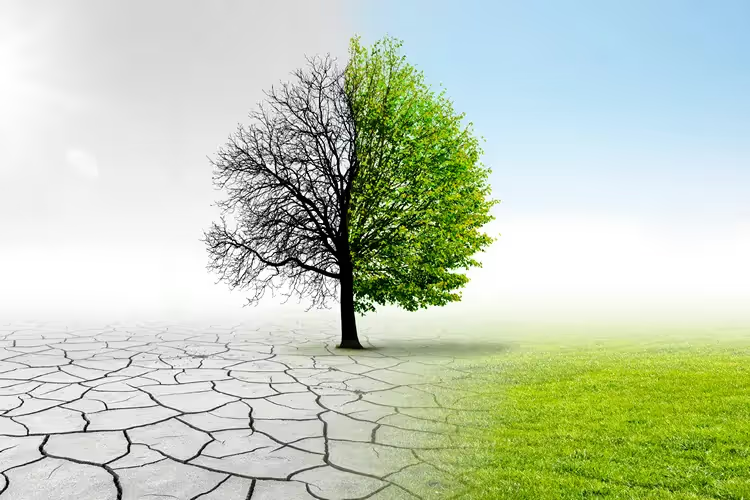The greenhouse effect is an essential natural process that keeps our planet warm and habitable. When sunlight reaches the Earth, a portion is reflected back into space, while the rest is absorbed, heating the planet. This warmth is then emitted as infrared radiation, which greenhouse gases in the atmosphere absorb and trap, preventing the heat from escaping into space. This intricate balance warms the Earth, making life as we know it possible. In this post, we'll learn how the greenhouse effect works and its critical role in maintaining our planet's climate.
What are Greenhouse Gases (GHG)?
1. Definition: Greenhouse gases are gases in Earth's atmosphere that trap heat. They allow sunlight to enter the atmosphere freely, but they prevent the heat that the sunlight brings from leaving the atmosphere.
2. Major Greenhouse Gases:
- Carbon Dioxide (CO₂): The most significant long-lived greenhouse gas in the atmosphere, largely released through burning fossil fuels, deforestation, and various industrial processes.
- Methane (CH₄): A potent greenhouse gas with a shorter atmospheric lifetime than CO₂ but a higher heat-trapping ability. It is emitted during the production and transport of coal, oil, and natural gas, as well as from livestock and other agricultural practices.
- Nitrous Oxide (N₂O): Emitted from agricultural and industrial activities, as well as during combustion of fossil fuels and solid waste.
- Fluorinated Gases: Synthetic gases used in a variety of industrial applications, including hydrofluorocarbons (HFCs), perfluorocarbons (PFCs), sulfur hexafluoride (SF₆), and nitrogen trifluoride (NF₃). Though present in smaller quantities, they have a high global warming potential (GWP).
- Water Vapor (H₂O): The most abundant greenhouse gas, but its concentration is largely controlled by natural processes rather than human activities.
3. Sources of Greenhouse Gases:
- Natural Sources: Include respiration, decomposition, ocean-atmosphere exchange, and volcanic activity.
- Anthropogenic Sources: Include burning of fossil fuels (coal, oil, natural gas), deforestation, industrial processes, agricultural activities, and waste management.
The Greenhouse Effect
1. How it Works: The greenhouse effect is a natural process that warms the Earth's surface. When the Sun’s energy reaches the Earth, some of it is reflected back to space and the rest is absorbed, warming the planet. The Earth then releases heat in the form of infrared radiation. Greenhouse gases absorb this infrared radiation and trap heat in the atmosphere, preventing it from escaping into space, thus warming the planet.
2. Enhanced Greenhouse Effect: Human activities have increased the concentration of greenhouse gases, enhancing the natural greenhouse effect, which leads to more heat being trapped and an overall warming of the Earth's climate. This enhanced effect is a primary driver of recent climate change.
Climate Change
1. Definition: Climate change refers to significant changes in global temperatures and weather patterns over time. While climate change is a natural phenomenon, recent trends are primarily driven by human activities that increase greenhouse gas concentrations in the atmosphere.
2. Evidence of Climate Change:
- Rising Temperatures: Global temperatures have risen significantly over the past century, with the past few decades being the warmest on record.
- Melting Ice and Glaciers: Arctic sea ice, glaciers, and ice sheets are melting at unprecedented rates.
- Sea Level Rise: Melting ice and the expansion of seawater as it warms have caused global sea levels to rise.
- Changing Weather Patterns: Increased frequency and severity of extreme weather events such as hurricanes, heatwaves, droughts, and heavy rainfall.
- Ocean Acidification: Increased CO₂ absorption by oceans is making them more acidic, impacting marine life.
3. Impacts of Climate Change:
- Environmental Impacts: Loss of biodiversity, changes in ecosystems, and increased frequency of natural disasters.
- Economic Impacts: Damage to infrastructure, increased costs for disaster response and recovery, and impacts on agriculture and food security.
- Social Impacts: Displacement of populations, health risks due to heatwaves and spread of diseases, and increased pressure on water resources.
Mitigation and Adaptation
1. Mitigation Strategies: Mitigation involves efforts to reduce or prevent the emission of greenhouse gases.
- Energy Efficiency: Improving energy use in buildings, transportation, and industries.
- Renewable Energy: Promoting wind, solar, hydro, and other renewable energy sources to replace fossil fuels.
- Carbon Capture and Storage (CCS): Capturing CO₂ emissions at their source and storing them underground.
- Reforestation and Afforestation: Planting trees to absorb CO₂ from the atmosphere.
- Sustainable Agriculture: Adopting farming practices that reduce emissions and enhance carbon sequestration.
2. Adaptation Strategies: Adaptation involves making adjustments to social, economic, and environmental practices to minimize the damage caused by climate change.
- Infrastructure Resilience: Designing buildings and infrastructure to withstand extreme weather events.
- Water Management: Improving water use efficiency and securing water supplies.
- Agricultural Practices: Developing crop varieties resistant to climate change impacts and improving soil management.
- Disaster Risk Management: Enhancing early warning systems and emergency response plans.
- Ecosystem Conservation: Protecting and restoring natural ecosystems to maintain their resilience.
Conclusion
Understanding greenhouse gases and their role in climate change is crucial for developing effective strategies to combat global warming. By mitigating emissions and adapting to changing conditions, societies can reduce the negative impacts of climate change and move towards a more sustainable and resilient future.

